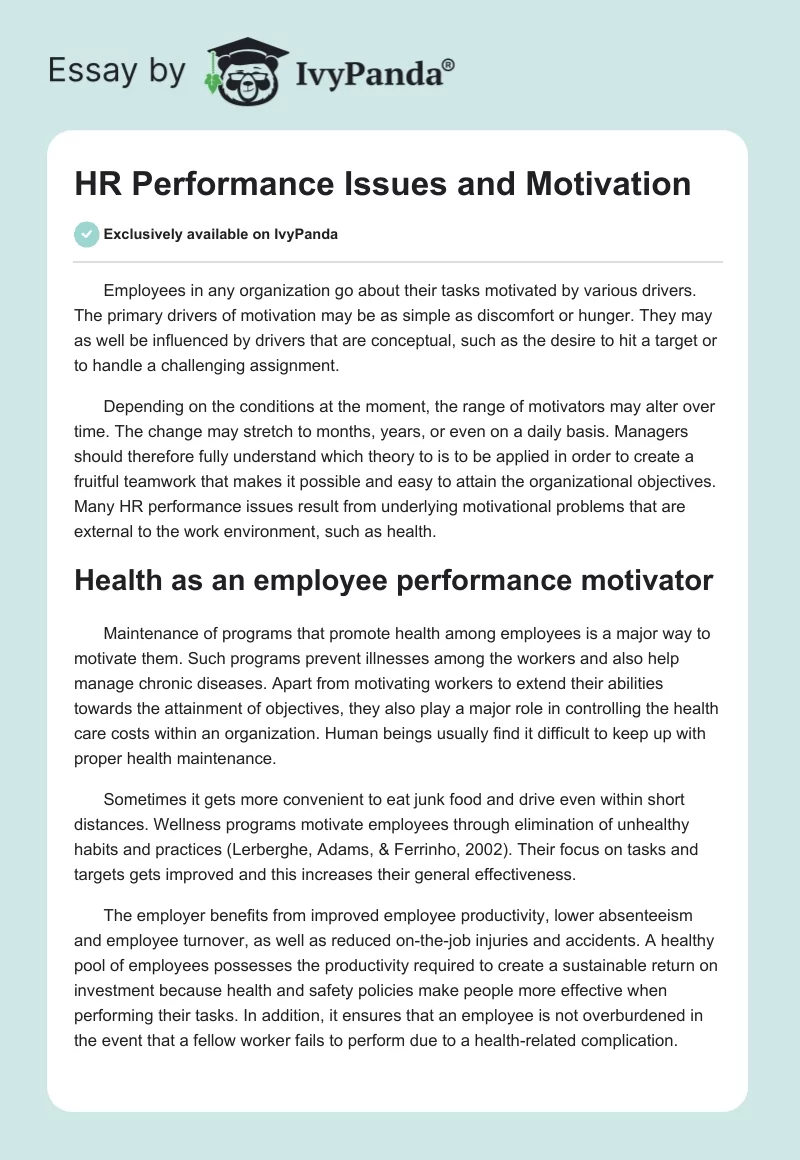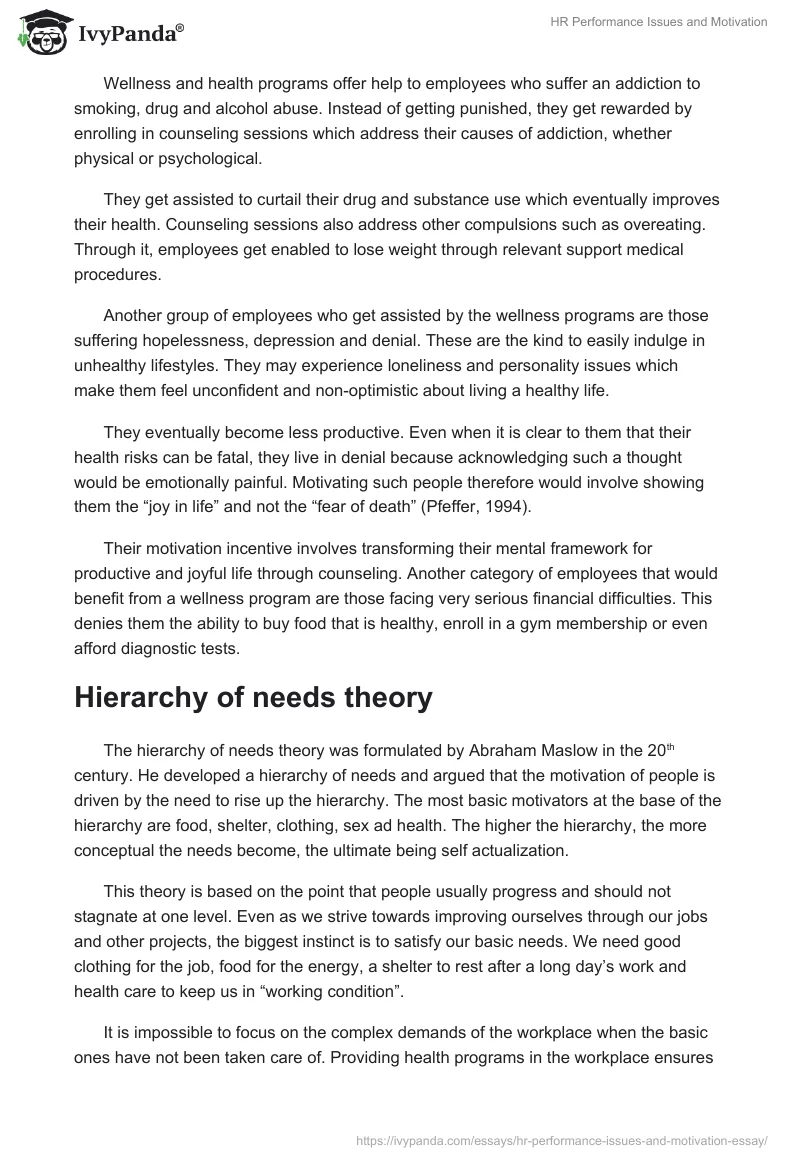Employees in any organization go about their tasks motivated by various drivers. The primary drivers of motivation may be as simple as discomfort or hunger. They may as well be influenced by drivers that are conceptual, such as the desire to hit a target or to handle a challenging assignment.
Depending on the conditions at the moment, the range of motivators may alter over time. The change may stretch to months, years, or even on a daily basis. Managers should therefore fully understand which theory to is to be applied in order to create a fruitful teamwork that makes it possible and easy to attain the organizational objectives. Many HR performance issues result from underlying motivational problems that are external to the work environment, such as health.
Health as an employee performance motivator
Maintenance of programs that promote health among employees is a major way to motivate them. Such programs prevent illnesses among the workers and also help manage chronic diseases. Apart from motivating workers to extend their abilities towards the attainment of objectives, they also play a major role in controlling the health care costs within an organization. Human beings usually find it difficult to keep up with proper health maintenance.
Sometimes it gets more convenient to eat junk food and drive even within short distances. Wellness programs motivate employees through elimination of unhealthy habits and practices (Lerberghe, Adams, & Ferrinho, 2002). Their focus on tasks and targets gets improved and this increases their general effectiveness.
The employer benefits from improved employee productivity, lower absenteeism and employee turnover, as well as reduced on-the-job injuries and accidents. A healthy pool of employees possesses the productivity required to create a sustainable return on investment because health and safety policies make people more effective when performing their tasks. In addition, it ensures that an employee is not overburdened in the event that a fellow worker fails to perform due to a health-related complication.
Wellness and health programs offer help to employees who suffer an addiction to smoking, drug and alcohol abuse. Instead of getting punished, they get rewarded by enrolling in counseling sessions which address their causes of addiction, whether physical or psychological.
They get assisted to curtail their drug and substance use which eventually improves their health. Counseling sessions also address other compulsions such as overeating. Through it, employees get enabled to lose weight through relevant support medical procedures.
Another group of employees who get assisted by the wellness programs are those suffering hopelessness, depression and denial. These are the kind to easily indulge in unhealthy lifestyles. They may experience loneliness and personality issues which make them feel unconfident and non-optimistic about living a healthy life.
They eventually become less productive. Even when it is clear to them that their health risks can be fatal, they live in denial because acknowledging such a thought would be emotionally painful. Motivating such people therefore would involve showing them the “joy in life” and not the “fear of death” (Pfeffer, 1994).
Their motivation incentive involves transforming their mental framework for productive and joyful life through counseling. Another category of employees that would benefit from a wellness program are those facing very serious financial difficulties. This denies them the ability to buy food that is healthy, enroll in a gym membership or even afford diagnostic tests.
Hierarchy of needs theory
The hierarchy of needs theory was formulated by Abraham Maslow in the 20th century. He developed a hierarchy of needs and argued that the motivation of people is driven by the need to rise up the hierarchy. The most basic motivators at the base of the hierarchy are food, shelter, clothing, sex ad health. The higher the hierarchy, the more conceptual the needs become, the ultimate being self actualization.
This theory is based on the point that people usually progress and should not stagnate at one level. Even as we strive towards improving ourselves through our jobs and other projects, the biggest instinct is to satisfy our basic needs. We need good clothing for the job, food for the energy, a shelter to rest after a long day’s work and health care to keep us in “working condition”.
It is impossible to focus on the complex demands of the workplace when the basic ones have not been taken care of. Providing health programs in the workplace ensures that the health of employees, being a basic need, is well addressed. An unhealthy worker lacks the efficiency required to perform well at work. In addition, the provision of insurance covers is essential so that employees can have access to medical care service from various medical centers at the organization’s cost (Diallo, Zurn, & Gupta, 2003).
This is designed to leave the employees with a higher disposable income. Medical bills are usually very high, and when an organization provides this to workers, it makes it easier for them to take care of their basic personal needs.
Actions to improve health care and motivate employees
Going by the hierarchy of needs theory, it is clear that the provision of health benefits in an organization leads to the motivation of employees and better productivity in the long run. The health benefits offered help workers save a lot of money and use it to satisfy their basic needs, as well as the needs of their families. Welfare programs and other health-related policies create job satisfaction and loyalty within the organization (Martinez & Martineau, 1998).
It is essential for the employers to work in cooperation with their employees so that they can detect and address their workers’ needs when it is necessary. A good employer-employee cohesion gives the employees the courage to voice their concerns regarding different issues. One mistake that many employers do is bossing over their workers. This forces the workers to keep working in uncomfortable conditions without raising their concerns in fear of losing their jobs.
It is good for employers to keep in mind that the employees represent families as they work, and that providing a nice employment package is actually benefiting the community at large. In this regard, extending health benefits like insurance policies to not only the employees but also to their families offers a great benefit.
This is because when an employee’s family member is having health complications, he or she cannot perform optimally. Many employees have family members that they feed, clothe, shelter and keep healthy. Punishing employees who have health issues such as addiction and hopelessness is foolhardy. Instead, they should be offered the relevant counseling and medication if need be. Health programs are about keeping employees in the right physical and psychological state for optimum productivity.
Reference List
Diallo, K., Zurn, P., & Gupta, N. (2003). Monitoring and Evaluation of Human Resources for Health: An International Perspective. Boston, MA: The Boston Consulting Group.
Lerberghe, W., Adams, G., & Ferrinho, P. (2002). Human Resources Impact Assessment. Bulletin of the World Health Organization. 80(7):525.
Martinez, J., & Martineau, T. (1998): Human Resources in Healthcare Reform: A Review of Current Issues. Health Policy and Planning. 13(4):345-358.
Pfeffer, J. (1994). Competitive Advantage through People. Boston, MA: Havard Business School Publishing.


